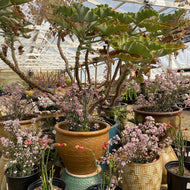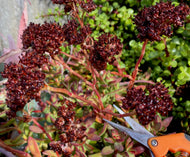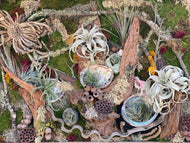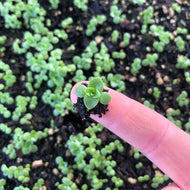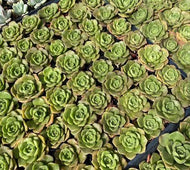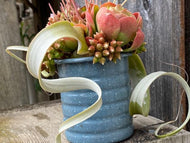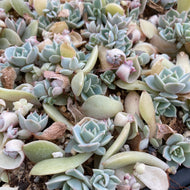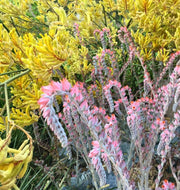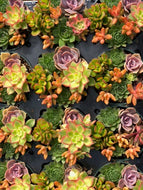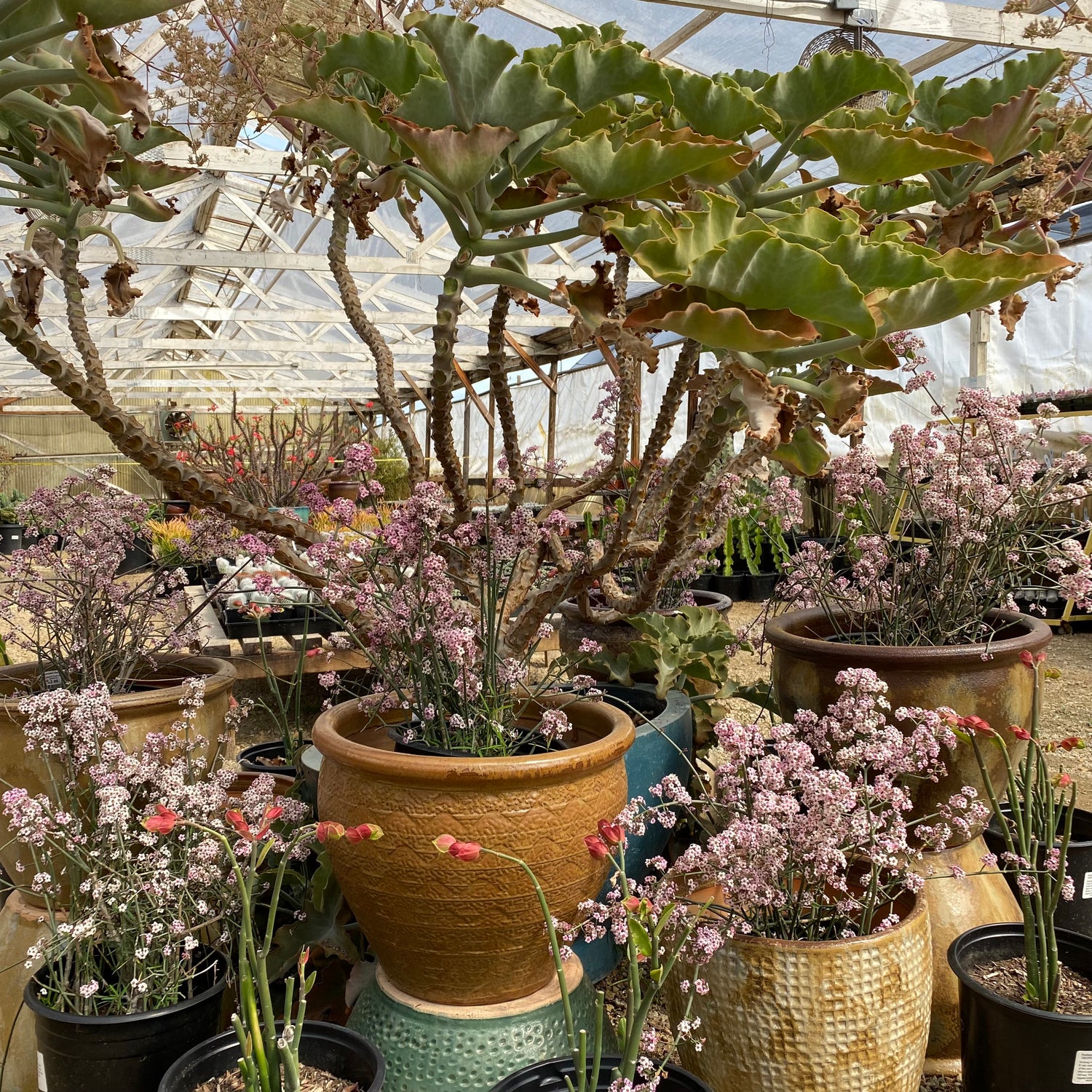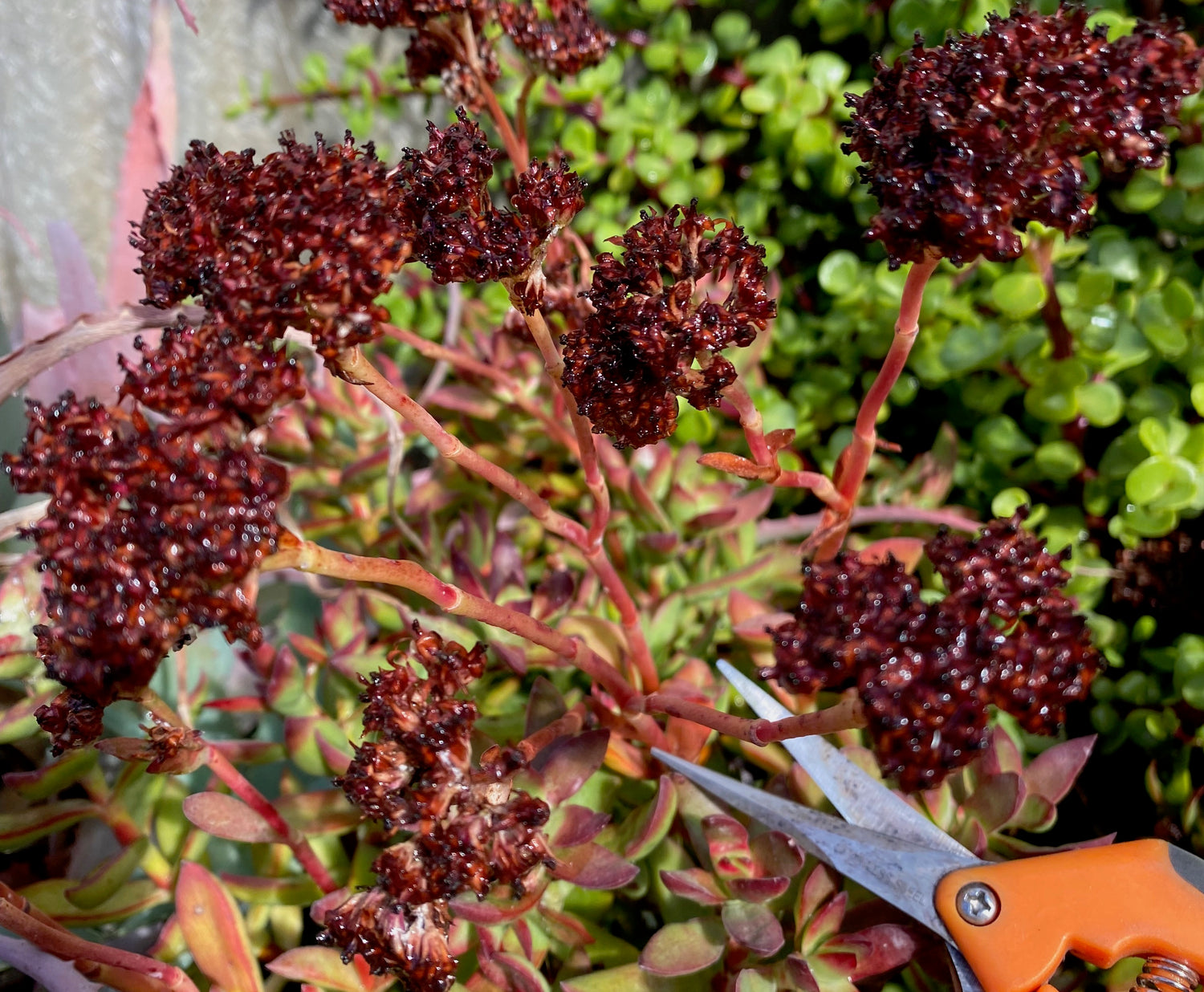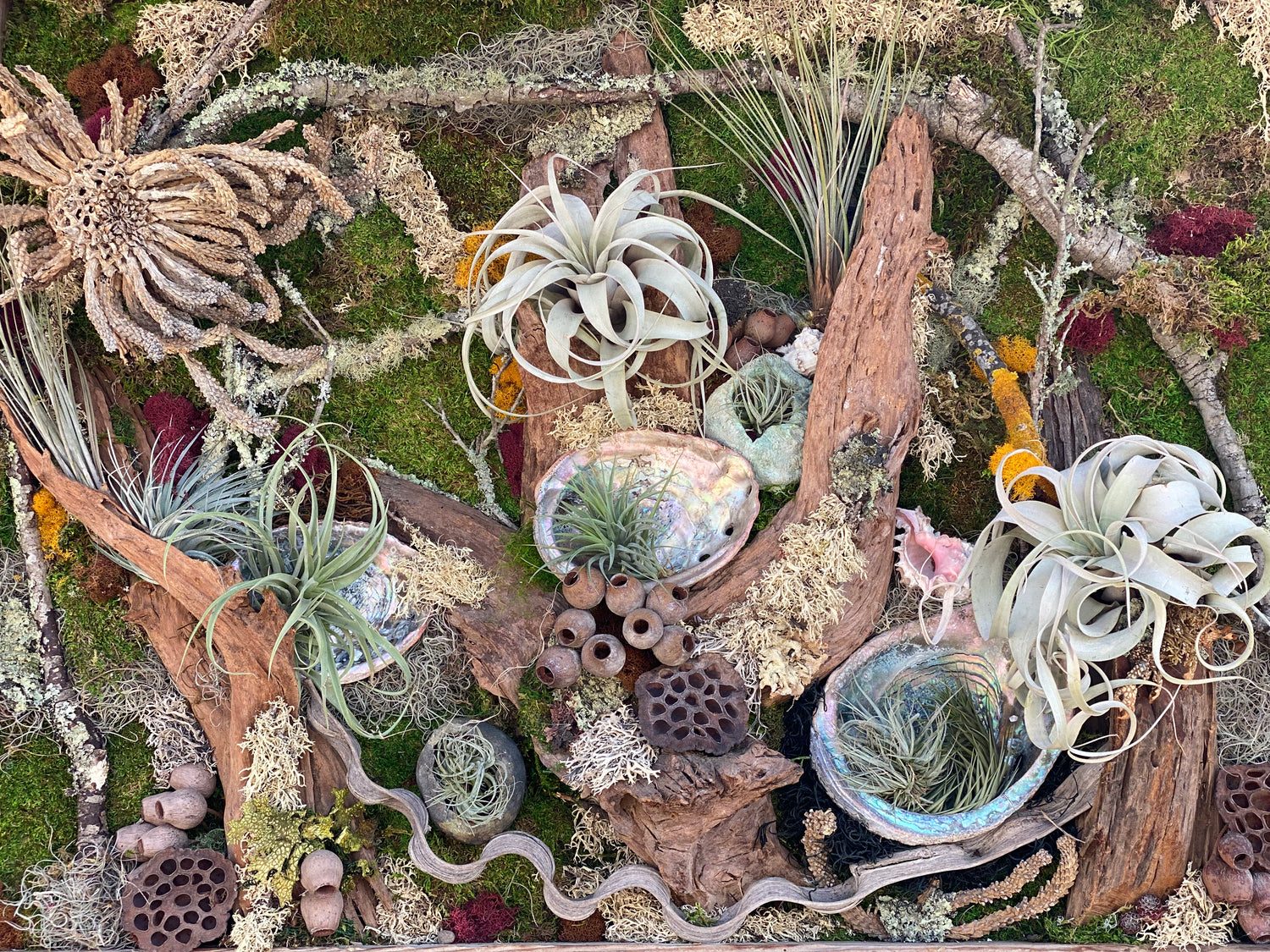
Talking with people about succulent care or observing succulent care "in the wild" has clearly demonstrated to me some of the confusion that exists throughout the world of horticulture with regard to succulent plants. Just take a walk through garden centers where highly trained nursery people are on staff. Beautifully maintained bedding plants, fruit trees, and a wide variety of ornamental plants abound, perfectly watered, fertilized, and maintained. Then seek out the succulent section. What you'll see are mislabeled, over watered, under watered and in general poorly maintained plants. I puzzled over this for many years as I was asked to help landscape professionals and retailers.
Just like caring for other plants, successful succulent care is a combination of several factors. Soil, water, fertilizer, exposure, pest and disease control, maintenance and most important, looking and questioning what is going on with the plants.
Looking and questioning what is going on with the plants. Yes, I have found this to be the most important factor in maintaining healthy and attractive succulent plants. If you are already a gardener with experience successfully growing other types of plants, then applying what you have learned to this group of plants will go a long way toward success with them. When a plant does not look healthy then it probably is not. A plant that is not healthy is probably dealing with issues related to soil, water, fertilizer, pest and disease control, maintenance or a combination of these issues like any other plant that does not appear to be healthy.
Succulent plants are slightly different from typical herbaceous perennial plants because succulents are plants that have adapted to environments in which water is unavailable for long periods of time. As a result of this, much of their uniqueness is related to their relationship with water. Succulent plants are very efficient when it comes to collecting and conserving water. They are also more subject to problems when exposed to too much water. Water management is one of the biggest defining factors in keeping succulents healthy.
Here is the general care knowledge you need to keep your succulents happy, from water to soil to sun exposure.
Soil
Good drainage and aeration are the key to soil mix in containers and in the landscape. Most packaged soil mixes are a bit too heavy and hold too much water for succulents. Amending traditional potting mixes by adding coarse perlite, crushed lava, or pumice will generally suffice to make a traditional potting mix a good succulent mix. I generally recommend combining 1 part amendment and 4 parts potting mix. The proportion of amendment can be increased for succulents like cacti that need even greater drainage and aeration.
If you would prefer to buy a pre-mixed soil, there are several good options on the market, such as the E.B. Stone Cactus mix that we stock at the nursery.
Water
Succulent plants are characterized by their thick stems and leaves that collect and store water efficiently. More traditional types of plants have thin leaves and need more frequent watering and hydration. On a hot day, a plant like a coleus might wilt, even though there is moisture in the soil. More frequent watering is necessary to increase humidity and water availability for the coleus. The succulent has water stored in its leaves and stem and so is less likely to wilt. Succulent plants like to approach dryness before being watered. As the soil dries, the last of the moisture is held in the root ball of the plant. Once this area is nearly dry, it is time to water. When watering, water thoroughly, so the water saturates evenly throughout the soil and a little water runs out the bottom of the plant. When you water a succulent, you water it pretty much like any other plant, just not as often.
An exception to how you water a succulent is when the conditions are not ideal. Cloudy dark days, poor light exposure and poor air circulation might be examples of this. In these environments, the plant will dry out very slowly, so measured watering, giving the plant smaller doses of water, will be necessary to keep the plant from being too wet over an extended period of time. Again-observing what the plant needs is key to healthy plants!
Fertilizer
Succulent plants, like most plants, appreciate being fed. The difference is, succulents are very efficient, so need less fertilizer less often than other plants. I do not recommend using any special fertilizer for succulents. As you gain expertise with the plants, experimenting with different fertilizers may well enhance the quality of the plants and or flowers. In the mean time, using any balanced fertilizer such as 10-10-10 or 20-20-20. The key is a well-balanced fertilizer to maintain a healthy growing plant. Many all-purpose fertilizers will fit the bill; at the nursery, we stock and recommend Maxsea All-Purpose Plant Food.
Too much fertilizer will encourage too much growth which makes the plant weedy looking. Too little will leave the plant in suspended animation, appearing to just sit there and not do anything. I suggest cutting the recommended dosage rate in half and fertilizing about once a month at the most. Fertilizing during the winter months is generally not necessary as most succulents are dormant during that time.
Exposure
Like most plants, succulent plants tend to like an environment that has good quality sunlight and some fresh air. There are a number of misunderstandings about succulents. Sunlight is one of the areas of misunderstanding. Many people think "desert" when the subject of succulents comes up. In fact, succulent plants are most attractive if they are grown with a little protection from hot sun. Growing succulent plants in a few hours of morning sun during the hotter months of the year will allow the plants to achieve good color and form without being parched by the heat of the mid day sun. In a southern exposure where the sun is shining on the area all day, shade cloth, lattice, or even the partial shading provided by a tree will help break up the heat of the sun. As winter approaches, more sun exposure will help the plant maintain good form and color. Too much sun and the plant will appear parched and burnt out. Too little sun and the plant will lose color and stretch for more sunlight, losing the compact form that is more attractive.
Cold Tolerance
Up until recently there has been a lack of information on the cold tolerance of different succulent plants. If you do not have any information on the cold tolerance of a particular plant, I suggest assuming the plant will either freeze or be damaged when the temperature goes below 32 degrees F, or freezing. There are simple materials, such as frost cloth, that can be used to cover plants during a light freeze. These materials work well to gain you about 4 to 6 degrees of protection.
Pest and Disease Control
An aphid is an aphid is an aphid. Just like most plants, bugs will attack succulent plants. The key is to look at your plants and if something is on them that looks out of place, look more closely, investigate. As with any other plant, the key to healthy succulents is good soil, proper watering and fertilizing, and the right exposure or environment. With the proper balance of these things you are less likely to have problems with bugs.
Reality with all plants is that there are bugs and diseases out there, and succulent plants can become the target of these things. Watching for bugs and disease is necessary with succulents as other plants. Aphids usually attack flowers and new growth on succulents just like they do on other plants. Mealy bugs lodge in between the leaves near the new growth or infest the soil living on the roots of the plant, just like other plants. Snails chew on the leaves, as do earwigs. Powdery mildew can appear on the leaves of succulents, particularly during long periods of inclement weather. Oh, and don't forget the ants. Ants are farmers. Just as you might rototill the soil and plant carrot seeds for your carrot juice habit, ants use plants like succulents to grow bugs that will help feed all of their ant buddies. Get rid of any ants you see on your plants.
So, these plants we call succulents are not bug-proof. They are very tough and can survive with an infestation for long periods, but healthy attractive plants need to be monitored, and when an infestation appears, it needs to be dealt with.
How you deal with an infestation is up to you. You might consult your local nursery person, or your friend the plant geek, to help identify the bug or disease. Whether you use organics or nuclear weapons, water, soap, q-tips or chemicals is up to you. The main thing is to deal with the problem as soon as you notice it.
Maintenance
Pruning, dividing, transplanting, deadheading, etc., are all things that apply to succulent plants, just like other plants. What makes succulents different than most other plants is how easy they are to handle when digging them up, transplanting, etc. Succulent plants do not experience the shock other plants do when the root system is disturbed. This is because succulent plants store their own water and do not experience the leaf wilt that other plants do when the root system is disturbed.
As a rule, succulent plants do not mind crowding whether the plants are grouped in one container or are alone and fully filled out in the container. Transplanting a plant that has filled its container will generally allow the plant to experience a new spurt of growth. I generally recommend moving up 2" in container size for individual plants. Succulents also appreciate a change of soil every 2 to 4 years. Plants that have grown together and are crowding each other will appreciate being thinned out and given a bit more space. Usually a reliable time of year to do transplanting is when the plants are beginning to grow, often in the spring.
So, in summary, look at your plants and if a plant does not look healthy show it the curiosity you would any other plant. Apply what plant knowledge you have gained to these plants as they are just plants. The key to healthy succulent plants is proper soil mix, watering, fertilizing, exposure, pest and disease control, and maintenance.
Happy succulenting!
MONTHLY NEWSLETTER
To learn more, sign up for our monthly newsletter. We feature a grower's note every month with more information about succulent care that is specific to each variety.

